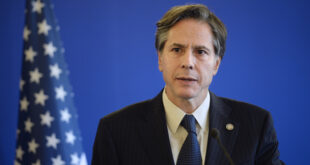In keeping status quo, Fed signals it’s done raising rates after string of increases.
For a third straight time, the U.S. Federal Reserve kept its key interest rate unchanged Wednesday, as it signalled its expectations to make a series of quarter-point cuts to the benchmark interest rate next year.
Those envisioned rate cuts — which wouldn’t likely begin until the second half of 2024 — suggest officials think high borrowing rates will still be needed for much of next year to further slow spending and inflation.
The unchanged rate is also a sign that the Fed is likely done with raising rates after having imposed the fastest string of increases in four decades to fight painfully high inflation.
In a statement issued after its 19-member policy committee met Wednesday, the Fed said “inflation has eased over the past year but remains elevated.”
It was the first time since inflation first spiked in 2021 that the Fed has formally acknowledged progress in its fight against accelerating prices. It also provided a hint that its rate-cut efforts may be over, saying it is considering whether “any additional” hikes are needed.
Benchmark rate at 5.4%
The Fed kept its benchmark rate at about 5.4 per cent, its highest level in 22 years. The rate that has led to much higher costs for mortgages, auto loans, business borrowing and many other forms of credit.
Higher mortgage rates have sharply reduced home sales. There has been a similar decline in spending on appliances and other expensive goods, which are often purchased on credit.
So far, the Fed has achieved what few observers thought possible a year ago: Bringing inflation down without bringing on an accompanying surge in unemployment or a recession, which typically coincide with a central bank’s efforts to cool the economy.
Though inflation remains above the Fed’s two per cent target, it has declined faster than officials had expected, allowing them to keep rates unchanged and wait to see if price increases continue to ease.
At the same time, the government’s latest report on consumer prices showed that inflation in some areas — particularly health care, apartment rents, restaurant meals and other services — remains persistently high, one reason why Federal Reserve chair Jerome Powell is reluctant to signal that policymakers are prepared to cut rates anytime soon.
On Wednesday, the Fed’s quarterly economic projections showed its officials envision a “soft landing” for the economy, in which inflation would continue its decline toward the central bank’s two per cent target without causing a steep downturn. The forecasts showed that the policymakers expect to cut their benchmark rate to 4.6 per cent by the end of 2024 — three quarter-point reductions from its current level.
A sharp economic slowdown could prompt even faster rate reductions. So far, though, there is no sign that a downturn is imminent.
Cuts could impact borrow, stocks
In its quarterly projections, the Fed’s policymakers now expect “core” inflation, according to its preferred measure, to fall to just 2.4 per cent by the end of 2024, down from the 2.6 per cent that was forecast in September. Core inflation, which excludes volatile food and energy costs, is considered a better gauge to inflation’s future path.
The policymakers foresee unemployment rising to 4.1 per cent next year from its current 3.7 per cent, which would still be a low level historically. They project that the economy will expand at a modest 1.4 per cent next year and 1.8 per cent in 2025.
Interest rate cuts by the Fed would reduce borrowing costs across the economy. Stock prices could rise, too, though share prices have already rallied in expectation of rate cuts, potentially limiting any further increases.
Powell, though, has recently downplayed the idea that rate reductions are nearing. He hasn’t yet even signalled that the Fed is conclusively done with its hikes.
One reason the Fed might be able to cut rates next year, even if the economy plows ahead, would be if inflation kept falling as expected. A steady slowdown in price increases would have the effect of raising inflation-adjusted interest rates, thereby making borrowing costs higher than the Fed intends.
In this scenario, reducing rates would simply keep inflation-adjusted borrowing costs from rising.
Positive news with jobs, prices
Recent economic data have modestly cooled financial markets’ expectations for early rate cuts. Last week’s jobs report for November showed that the unemployment rate fell to 3.7 per cent, near a half-century low, down from 3.9 per cent as businesses engaged in solid hiring. Such a low unemployment rate could force companies to keep raising pay to find and retain workers, which would fuel inflationary pressures.
And consumer prices were mostly unchanged last month, the government said Tuesday, suggesting that while inflation is likely headed back to the Fed’s two per cent target, it might take longer than optimists expect. The central bank, as a result, could opt to keep rates at the current level to try to ensure that prices resume their downward path.
The Fed is the first of several major central banks to meet this week, with others also expected to keep their rates on hold. Both the European Central Bank and the Bank of England will decide on their next moves Thursday.
*****
Credit belongs to : www.cbc.ca
 Atin Ito First Filipino Community Newspaper in Ontario
Atin Ito First Filipino Community Newspaper in Ontario






